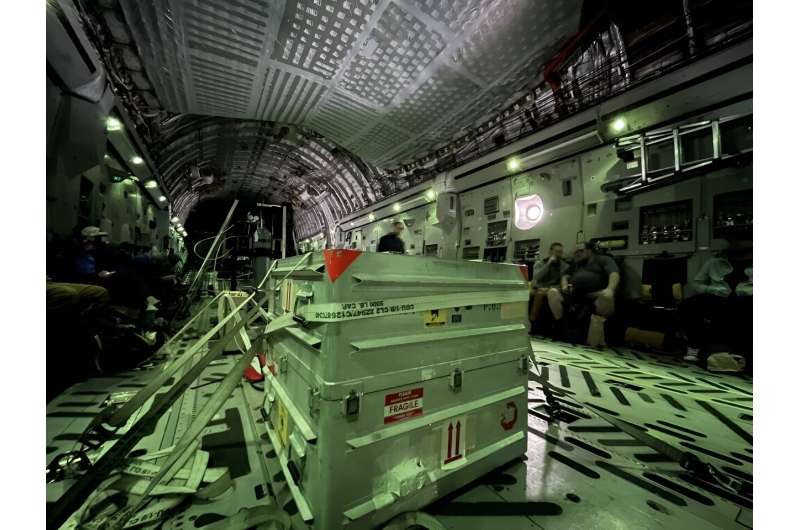This article has been reviewed according to Science X's editorial process and policies. Editors have highlighted the following attributes while ensuring the content's credibility:
fact-checked
trusted source
proofread
NASA's OSIRIS-REx capsule arrives in Houston

The first U.S. asteroid sample, delivered by the OSIRIS-REx spacecraft to Earth on Sept. 24, has arrived at its permanent home at NASA's Johnson Space Center in Houston, where it will be cared for, stored, and distributed to scientists worldwide.
The sample arrived in Houston at 12:40 pm ET (11:40 am CT) aboard a U.S. Air Force C-17 aircraft, which landed at Ellington Field. From there, it was transferred to NASA Johnson.
The team will spend the next few weeks in the clean room at Johnson built exclusively for Bennu samples. The clean room includes custom glove boxes built to fit the sample canister containing the TAGSAM (Touch-and-Go Sample Acquisition Mechanism) head inside. The TAGSAM head was on the end of a robotic arm that collected rocks and dust from asteroid Bennu's surface on October 20, 2020.
Having practiced these procedures for months, scientists and technicians plan to proceed through the many steps of removing the sample from the TAGSAM. First, they plan to place the canister in the glove box and disassemble it. Then, they plan to remove the TAGSAM head, where scientists expect most sample to be, cataloging and storing every piece of hardware and asteroid dust found outside of it.
Researchers plan to analyze asteroid dust from the initial disassembly for an early glimpse into the chemical, mineralogical, and physical characteristics and rock types that may be found in the bulk sample.

NASA plans to share these initial findings, plus first images of the sample, in a live broadcast on October 11.
NASA's OSIRIS-REx, the first U.S. mission to collect a sample from an asteroid, will return to Earth on Sept. 24, 2023, with material from asteroid Bennu. When it arrives, the OSIRIS-REx spacecraft will release the sample capsule for a safe landing in the Utah desert. The pristine material from Bennu—rocks and dust collected from the asteroid's surface in 2020—will offer generations of scientists a window into the time when the sun and planets were forming about 4.5 billion years ago.
More information: Learn more about the OSIRIS-REx mission.
Provided by NASA's Goddard Space Flight Center





















